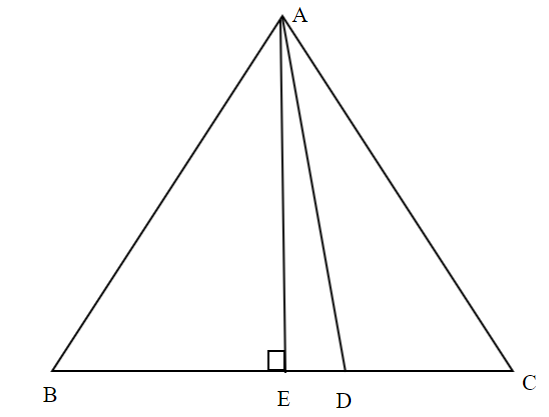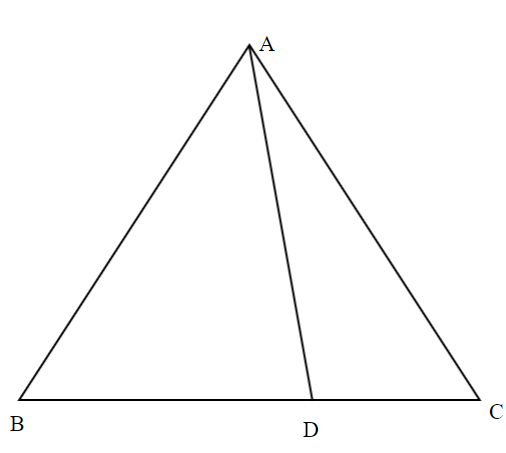Answer
423.3k+ views
Hint: In this question we will do some construction and also apply the Pythagoras theorem to solve the given problem.
Complete step-by-step answer:
Now, to solve this problem we will construct a perpendicular from vertex A to base BC. Drawing AE perpendicular to BC.

Now we will apply the Pythagorean theorem in right – angled triangles ABE and AEC.
Pythagorean theorem states that in a right – angled triangle the sum of square of base and perpendicular is equal to the square of hypotenuse on the largest side of the triangle. So, in a triangle ABC, right – angled at C,
${\text{A}}{{\text{B}}^2}{\text{ = A}}{{\text{C}}^2}{\text{ + B}}{{\text{C}}^2}$
Where AC is the perpendicular and BC is the base of the triangle ABC.
Now, applying Pythagoras theorem in triangle ABE, we get
${\text{A}}{{\text{B}}^2}{\text{ = B}}{{\text{E}}^2}{\text{ + A}}{{\text{E}}^2}$ …… (1)
Applying Pythagoras theorem in triangle AEC,
${\text{A}}{{\text{C}}^2}{\text{ = A}}{{\text{E}}^2}{\text{ + E}}{{\text{C}}^2}$ ……. (2)
Now, adding equation (1) and (2),
${\text{A}}{{\text{B}}^2}{\text{ + A}}{{\text{C}}^2}{\text{ = A}}{{\text{E}}^2}{\text{ + B}}{{\text{E}}^2}{\text{ + E}}{{\text{C}}^2}{\text{ + A}}{{\text{E}}^2}$
${\text{A}}{{\text{B}}^2}{\text{ + A}}{{\text{C}}^2}{\text{ = 2A}}{{\text{E}}^2}{\text{ + B}}{{\text{E}}^2}{\text{ + E}}{{\text{C}}^2}$
BE = BD – ED and EC = ED + DC
${\text{A}}{{\text{B}}^2}{\text{ + A}}{{\text{C}}^2}{\text{ = 2A}}{{\text{E}}^2}{\text{ + (BD - ED}}{{\text{)}}^2}{\text{ + (ED + DC}}{{\text{)}}^2}$
Solving the above equation, we get
${\text{A}}{{\text{B}}^2}{\text{ + A}}{{\text{C}}^2}{\text{ = 2A}}{{\text{E}}^2}{\text{ + B}}{{\text{D}}^2}{\text{ + E}}{{\text{D}}^2}{\text{ - 2BDED + E}}{{\text{D}}^2}{\text{ + D}}{{\text{C}}^2}{\text{ + 2EDDC}}$
Now, AD is the median so, BD = DC
So,
${\text{A}}{{\text{B}}^2}{\text{ + A}}{{\text{C}}^2}{\text{ = 2A}}{{\text{E}}^2}{\text{ + B}}{{\text{D}}^2}{\text{ + E}}{{\text{D}}^2}{\text{ - 2DCED + E}}{{\text{D}}^2}{\text{ + D}}{{\text{C}}^2}{\text{ + 2EDDC}}$
${\text{A}}{{\text{B}}^2}{\text{ + A}}{{\text{C}}^2}{\text{ = 2A}}{{\text{E}}^2}{\text{ + B}}{{\text{D}}^2}{\text{ + E}}{{\text{D}}^2}{\text{ + E}}{{\text{D}}^2}{\text{ + D}}{{\text{C}}^2}$
${\text{A}}{{\text{B}}^2}{\text{ + A}}{{\text{C}}^2}{\text{ = 2(A}}{{\text{E}}^2}{\text{ + B}}{{\text{D}}^2}{\text{ + E}}{{\text{D}}^2})$ as BD = DC …. (3)
Now from triangle AED,
${\text{A}}{{\text{D}}^2}{\text{ = A}}{{\text{E}}^2}{\text{ + E}}{{\text{D}}^2}$
Putting this value in equation (3), we get
${\text{A}}{{\text{B}}^2}{\text{ + A}}{{\text{C}}^2}{\text{ = 2(A}}{{\text{D}}^2}{\text{ + B}}{{\text{D}}^2})$
Hence proved.
Note: While solving such types of questions, you have to think how you can solve the given problem. By carefully seeing the figure given and understanding the question you can easily know which property you have to use to solve the question. Also, carefully apply the property you use to get the correct answer.
Complete step-by-step answer:
Now, to solve this problem we will construct a perpendicular from vertex A to base BC. Drawing AE perpendicular to BC.

Now we will apply the Pythagorean theorem in right – angled triangles ABE and AEC.
Pythagorean theorem states that in a right – angled triangle the sum of square of base and perpendicular is equal to the square of hypotenuse on the largest side of the triangle. So, in a triangle ABC, right – angled at C,
${\text{A}}{{\text{B}}^2}{\text{ = A}}{{\text{C}}^2}{\text{ + B}}{{\text{C}}^2}$
Where AC is the perpendicular and BC is the base of the triangle ABC.
Now, applying Pythagoras theorem in triangle ABE, we get
${\text{A}}{{\text{B}}^2}{\text{ = B}}{{\text{E}}^2}{\text{ + A}}{{\text{E}}^2}$ …… (1)
Applying Pythagoras theorem in triangle AEC,
${\text{A}}{{\text{C}}^2}{\text{ = A}}{{\text{E}}^2}{\text{ + E}}{{\text{C}}^2}$ ……. (2)
Now, adding equation (1) and (2),
${\text{A}}{{\text{B}}^2}{\text{ + A}}{{\text{C}}^2}{\text{ = A}}{{\text{E}}^2}{\text{ + B}}{{\text{E}}^2}{\text{ + E}}{{\text{C}}^2}{\text{ + A}}{{\text{E}}^2}$
${\text{A}}{{\text{B}}^2}{\text{ + A}}{{\text{C}}^2}{\text{ = 2A}}{{\text{E}}^2}{\text{ + B}}{{\text{E}}^2}{\text{ + E}}{{\text{C}}^2}$
BE = BD – ED and EC = ED + DC
${\text{A}}{{\text{B}}^2}{\text{ + A}}{{\text{C}}^2}{\text{ = 2A}}{{\text{E}}^2}{\text{ + (BD - ED}}{{\text{)}}^2}{\text{ + (ED + DC}}{{\text{)}}^2}$
Solving the above equation, we get
${\text{A}}{{\text{B}}^2}{\text{ + A}}{{\text{C}}^2}{\text{ = 2A}}{{\text{E}}^2}{\text{ + B}}{{\text{D}}^2}{\text{ + E}}{{\text{D}}^2}{\text{ - 2BDED + E}}{{\text{D}}^2}{\text{ + D}}{{\text{C}}^2}{\text{ + 2EDDC}}$
Now, AD is the median so, BD = DC
So,
${\text{A}}{{\text{B}}^2}{\text{ + A}}{{\text{C}}^2}{\text{ = 2A}}{{\text{E}}^2}{\text{ + B}}{{\text{D}}^2}{\text{ + E}}{{\text{D}}^2}{\text{ - 2DCED + E}}{{\text{D}}^2}{\text{ + D}}{{\text{C}}^2}{\text{ + 2EDDC}}$
${\text{A}}{{\text{B}}^2}{\text{ + A}}{{\text{C}}^2}{\text{ = 2A}}{{\text{E}}^2}{\text{ + B}}{{\text{D}}^2}{\text{ + E}}{{\text{D}}^2}{\text{ + E}}{{\text{D}}^2}{\text{ + D}}{{\text{C}}^2}$
${\text{A}}{{\text{B}}^2}{\text{ + A}}{{\text{C}}^2}{\text{ = 2(A}}{{\text{E}}^2}{\text{ + B}}{{\text{D}}^2}{\text{ + E}}{{\text{D}}^2})$ as BD = DC …. (3)
Now from triangle AED,
${\text{A}}{{\text{D}}^2}{\text{ = A}}{{\text{E}}^2}{\text{ + E}}{{\text{D}}^2}$
Putting this value in equation (3), we get
${\text{A}}{{\text{B}}^2}{\text{ + A}}{{\text{C}}^2}{\text{ = 2(A}}{{\text{D}}^2}{\text{ + B}}{{\text{D}}^2})$
Hence proved.
Note: While solving such types of questions, you have to think how you can solve the given problem. By carefully seeing the figure given and understanding the question you can easily know which property you have to use to solve the question. Also, carefully apply the property you use to get the correct answer.
Recently Updated Pages
Three beakers labelled as A B and C each containing 25 mL of water were taken A small amount of NaOH anhydrous CuSO4 and NaCl were added to the beakers A B and C respectively It was observed that there was an increase in the temperature of the solutions contained in beakers A and B whereas in case of beaker C the temperature of the solution falls Which one of the following statements isarecorrect i In beakers A and B exothermic process has occurred ii In beakers A and B endothermic process has occurred iii In beaker C exothermic process has occurred iv In beaker C endothermic process has occurred

The branch of science which deals with nature and natural class 10 physics CBSE

The Equation xxx + 2 is Satisfied when x is Equal to Class 10 Maths

Define absolute refractive index of a medium

Find out what do the algal bloom and redtides sign class 10 biology CBSE

Prove that the function fleft x right xn is continuous class 12 maths CBSE

Trending doubts
Difference Between Plant Cell and Animal Cell

Difference between Prokaryotic cell and Eukaryotic class 11 biology CBSE

Fill the blanks with the suitable prepositions 1 The class 9 english CBSE

Change the following sentences into negative and interrogative class 10 english CBSE

Summary of the poem Where the Mind is Without Fear class 8 english CBSE

Give 10 examples for herbs , shrubs , climbers , creepers

Write an application to the principal requesting five class 10 english CBSE

What organs are located on the left side of your body class 11 biology CBSE

What is the z value for a 90 95 and 99 percent confidence class 11 maths CBSE




